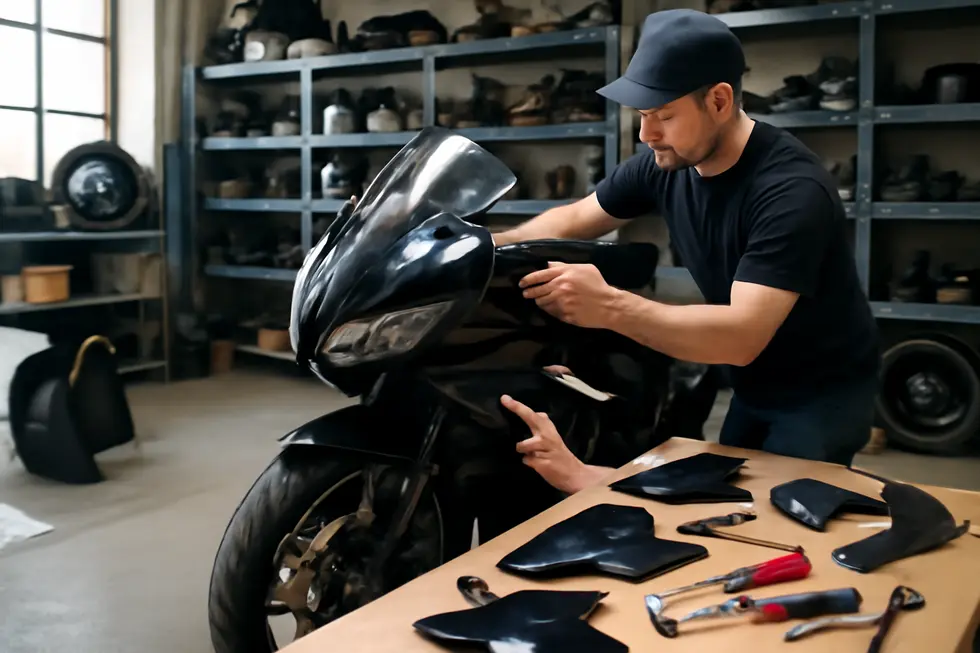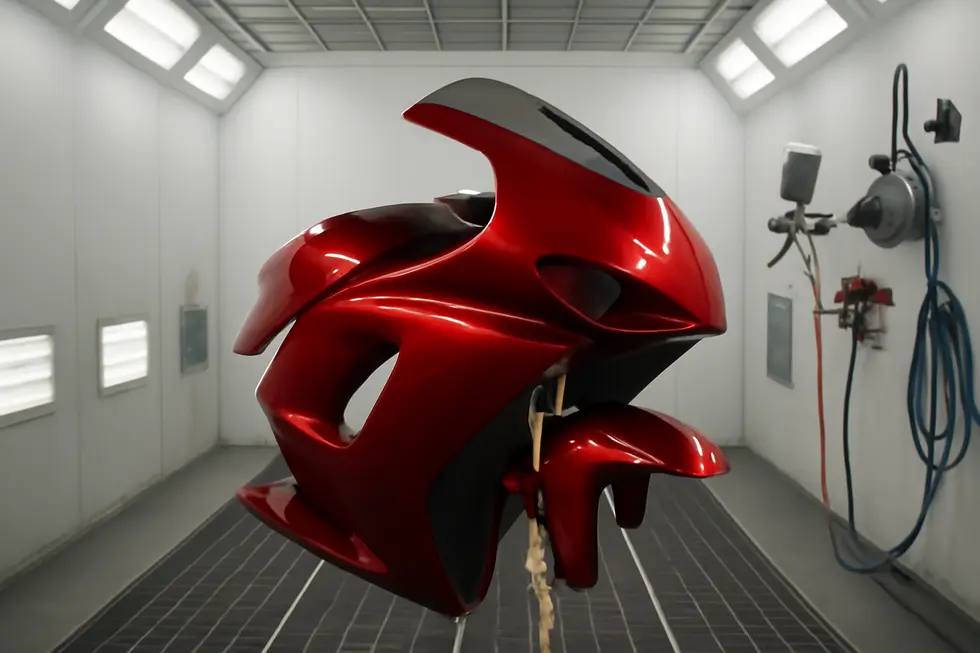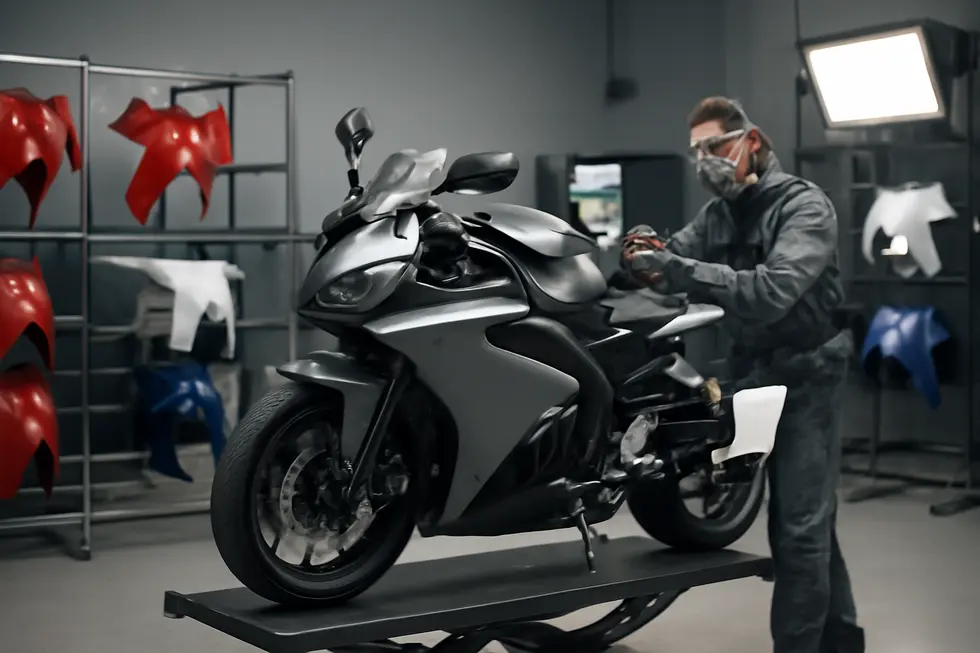Mastering Motorcycle Fairing Paint Jobs: From Prep to Longevity
October 11, 2025 | by summitfairings
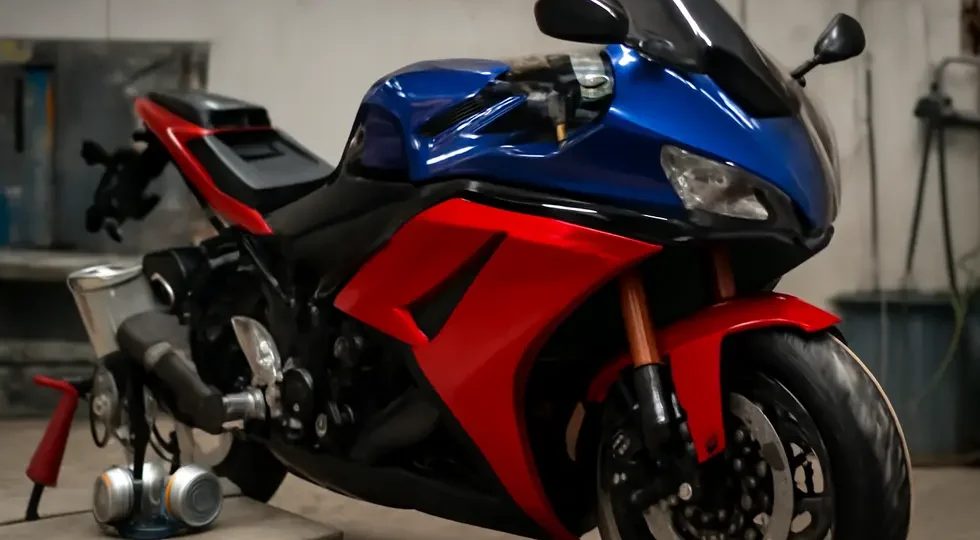
Introduction
A professionally executed motorcycle fairing paint job significantly elevates a bike’s aesthetics and market value, attracting a discerning clientele. Understanding the meticulous process underscores the importance such services hold for business owners catering to motorcycle enthusiasts. Surface preparation is the foundation for paint adherence and finish quality, setting the stage for vibrant, long-lasting color applications and custom designs that distinguish one bike from another. Finally, proper maintenance strategies ensure that the paint job’s brilliance and durability persist over time, reducing return jobs and enhancing customer satisfaction. This overview delivers insights into each critical phase, empowering businesses to optimize their painting workflows and customer offerings.
Tables of Contents
Chapter 1: Mastering Surface Preparation and Priming for a Perfect Motorcycle Fairing Paint Job
- Essential Cleaning, Degreasing, and Initial Preparation Techniques for Motorcycle Fairings
- Mastering Sanding and Defect Management: Elevating Fairing Surface Quality Before Priming
- Ensuring Optimal Adhesion: Final Decontamination and Choosing the Perfect Primer
- Mastering Surface Prep and Primer Application: Industrial and DIY Methods for Flawless Motorcycle Fairing Finishes
Chapter 2: Color Application and Custom Design Techniques in Motorcycle Fairing Paint Job
- Mastering Paint Layers: Techniques and Materials for Vibrant Motorcycle Fairings
- Innovative Design Blending and Finishing Accents for Motorcycle Fairings
- Mastering Polishing and Surface Preparation for Flawless Custom Motorcycle Fairings
- Mastering Deep Vibrancy and Visibility: Candy Paint and Fluorescent Coatings for Motorcycle Fairings
Chapter 3: Maintenance and Longevity of Motorcycle Fairing Paint Job
- Essential Care Techniques to Preserve Motorcycle Fairing Paint’s Vibrancy and Durability
- Protecting and Restoring Motorcycle Fairings: Tackling Oxidation, Imperfections, and Effective Repairs
- Essential Protective Strategies to Shield Motorcycle Fairings From UV Damage and Environmental Wear
- Protecting and Preserving Your Motorcycle Fairing Paint: Key Factors that Influence Durability and Appearance
Chapter 1: Mastering Surface Preparation and Priming for a Perfect Motorcycle Fairing Paint Job
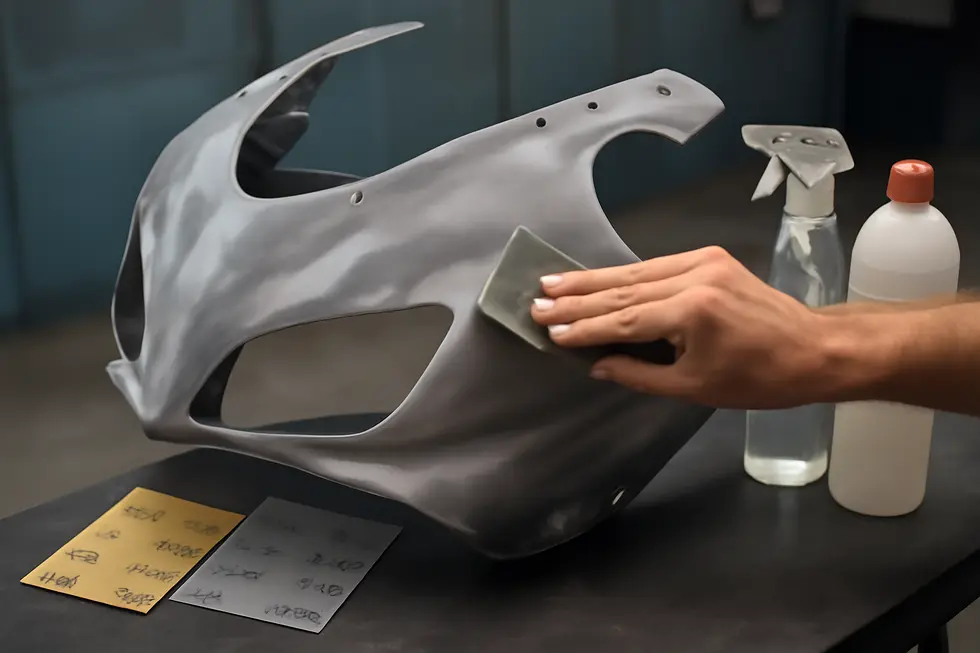
1. Essential Cleaning, Degreasing, and Initial Preparation Techniques for Motorcycle Fairings
Achieving a flawless and durable paint job on motorcycle fairings begins with meticulous surface preparation. The first and most crucial phase involves thorough cleaning and degreasing to remove dirt, oils, and other contaminants that impede paint adhesion. Using gentle cleaning agents, such as mild soap combined with soft sponges or microfiber cloths, ensures the fairing surface is cleaned without risk of scratching or damaging the plastic or existing coatings. After washing, drying with a soft towel helps prevent water spots that could affect the primer’s bond.
Once the surface is clean, degreasing is vital to eradicate any residual oils or waxes that might remain invisible but disrupt the painting process. This step assures that no substances interfere with the primer’s ability to form a strong foundation. For fairings exhibiting deeper scratches or imperfections, careful sanding with progressively finer grit sandpapers is necessary. Starting with coarser grits to level out damages, the process transitions to finer grades to smooth the surface in preparation for priming.
When imperfections are significant, filling compounds specifically designed for plastic fairings can be applied to restore uniformity. After curing, these areas are sanded flush with the surrounding surface to maintain a seamless finish. Priming then seals the prepared fairing, creating an ideal base for paint adhesion and increasing durability. It is important to choose a primer compatible with the fairing material to prevent adverse reactions and ensure longevity.
Throughout these initial stages, uninterrupted attention to detail and patience are key. Proper cleaning, degreasing, and surface leveling produce a uniform substrate that optimizes primer performance and sets the stage for the subsequent sanding, refinement, and defect management required before painting. For deeper insights into fairing preparation and finishing, explore comprehensive resources detailing the step-by-step process at Summit Fairings’ blog.
2. Mastering Sanding and Defect Management: Elevating Fairing Surface Quality Before Priming
Achieving a pristine paint finish on motorcycle fairings starts with meticulous sanding and rigorous defect management. After initial cleaning to remove all dirt and grease, the surface must be refined through wet sanding using progressively finer grit sandpapers—commonly moving from a coarser grit to ultra-fine grits between 1500 and 2000. This gradual smoothing eradicates minor scratches and evens out imperfections, creating an ideal texture for paint adhesion. During this process, care is essential to apply only light pressure to avoid damaging the often delicate plastic fairings.
Beyond simple smoothing, spotting defects such as dents or deeper scratches is critical. These flaws require precise correction with spot fillers or touch-up paint before further sanding. Seamlessly blending these repairs by sanding ensures no irregularities will appear through subsequent paint layers. After every sanding stage, thorough washing and drying are crucial to remove dust and residue that could compromise primer and paint bonding.
The primer step relies heavily on this well-prepared surface. Using a plastic-specific adhesion promoter or primer sprayed in thin, even coats not only enhances coverage but also guards against peeling and flaking. It subtly fills minor surface irregularities, laying a sturdy, uniform foundation for the base coats. Allowing the primer to dry fully before moving ahead guarantees optimal paint durability.
Following these detailed sanding and defect management methods results in a smooth, clean base layer that unlocks peak adhesion and longevity in your motorcycle fairing’s paint job. For those seeking deeper insight, a comprehensive tutorial on buffing and preparation offers invaluable tips and visual guidance, helping to perfect these essential steps.
Explore more about perfecting motorcycle fairings preparation at Summit Fairings blog.
3. Ensuring Optimal Adhesion: Final Decontamination and Choosing the Perfect Primer
Achieving a long-lasting and flawless paint job on motorcycle fairings hinges on meticulous final decontamination paired with the careful selection of an appropriate primer. After sanding and initial surface refinement, the fairing’s surface must be painstakingly cleared of all contaminants that impede paint adhesion. This involves sequential washing to remove dirt, degreasing to eliminate any oils or wax residues, and a final wipe-down using solvents like isopropyl alcohol to ensure the surface is perfectly clean and dry. This thorough decontamination step is non-negotiable, as even minute traces of contaminants can lead to adhesion failure, bubbling, or uneven paint texture.
Selecting the right primer is equally critical. Given that most motorcycle fairings are made from ABS plastic, primers designed specifically for plastics are required to ensure flexibility and strong adhesion. The primer should not only bond well but also have sufficient filling ability to smooth out minor scratches or surface inconsistencies that remain after sanding. Sandability of the primer is essential, enabling a smooth, uniform base for the color coats without causing surface scratches or clogging sandpaper.
Durability factors such as chemical resistance and flexibility must be considered since the fairings endure vibrations, temperature changes, and exposure to weather elements. While corrosion resistance is more relevant to metal components, it can benefit fasteners or metal attachments on the fairing. Two-component (2K) primers often provide superior hardness, chemical resistance, and longevity, making them a preferred choice in professional paint jobs.
Following this careful cleaning and primer selection, the primer is applied evenly with adequate drying and sanding between coats to achieve a flawless surface. This foundation stage is vital for both the look and durability of the paint system. For further insight into the broader painting process and quality fairings, visit this ultimate source for affordable motorcycle fairings.
4. Mastering Surface Prep and Primer Application: Industrial and DIY Methods for Flawless Motorcycle Fairing Finishes
Surface preparation and priming form the foundation of any successful motorcycle fairing paint job, whether approached industrially or through DIY methods. Achieving a durable and visually striking finish begins with meticulous cleaning to remove dirt, oils, and residues that would otherwise impair paint adhesion. This step employs gentle cleaners safe for ABS plastics, ensuring the surface remains intact and ready for further work.
Sanding follows, smoothing imperfections and lightly abrading the surface to create the necessary texture for primer bonding. Wet sanding with fine grit sandpapers—often ranging from 1500 to 2000 grit—is preferred to minimize heat and dust buildup, preserving the integrity of the fairing. This process requires patience and care to avoid substrate damage, especially when repairing scratches or blemishes that may need a touch of filler or paint before final sanding.
Priming is key to bridging the gap between the plastic substrate and the paint layers. Using plastic-compatible primers, the surface gains enhanced adhesion, reduced risk of peeling, and a uniform base color. Industrial applications benefit from controlled spray booths delivering even coats, while DIY enthusiasts often rely on aerosol primers sprayed evenly with adequate drying and light sanding between layers. This careful approach prevents imperfections and ensures a flawless base for subsequent paint application.
The paint finishing process builds on this foundation with multiple base and color coats, followed by a protective clear coat that adds gloss and shields the surface from UV rays and environmental wear. Whether done with professional-grade spray guns or carefully handled aerosol cans, consistent technique and drying times remain paramount. Final polishing—either machine-assisted or manual—brings out a showroom-quality shine, completing the transformation.
For deeper insights on preparing and polishing motorcycle fairings, visit a detailed guide on buffing motorcycle fairings. This integrated process highlights how thorough surface prep and primer application underpin the longevity and appeal of any fairing paint job.
Chapter 2: Color Application and Custom Design Techniques in Motorcycle Fairing Paint Job
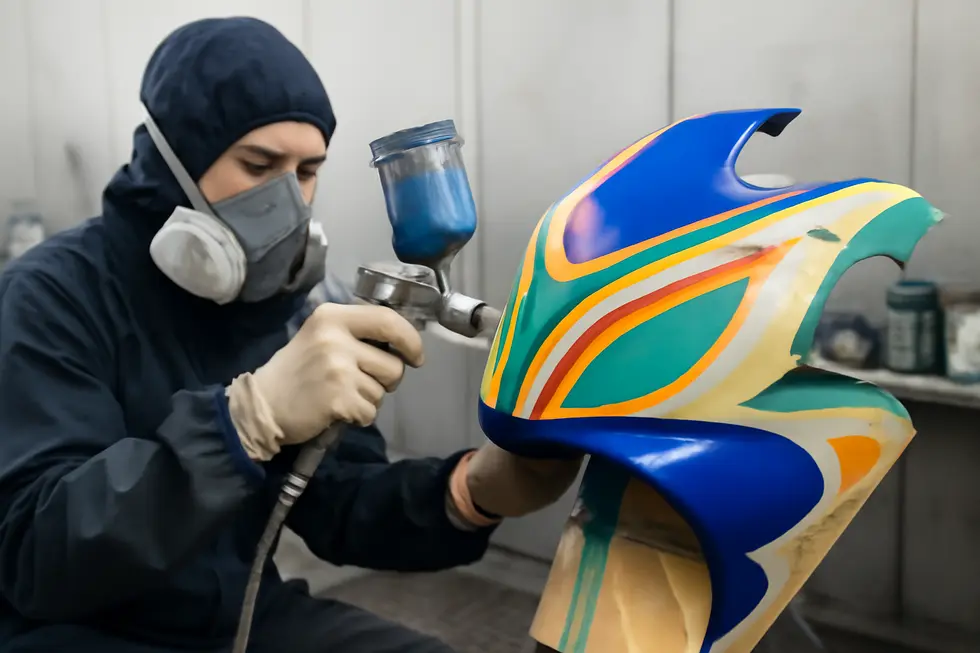
1. Mastering Paint Layers: Techniques and Materials for Vibrant Motorcycle Fairings
Achieving a striking and durable paint job on motorcycle fairings hinges on expert application methods paired with carefully chosen materials. The journey begins with meticulous surface preparation—ensuring the plastic surface is clean, sanded smoothly, and free of grease to promote optimal paint adhesion. Once prepared, an adhesive promoter or plastic-friendly primer is applied in light, even coats. This critical base layer establishes a uniform surface, enhances paint bonding, and prevents peeling.
The application of the base color is performed with precision, typically using spray guns or aerosol cans. Maintaining a consistent spray distance and smooth, overlapping motion avoids uneven buildup or runs. Multiple thin coats build depth and consistency better than one heavy pass. Beyond standard paints, advanced techniques allow customization with special color effects. Candy paints, using translucent inks layered over reflective bases, create luminous finishes that capture light with depth and sheen. Crystal effect paints incorporate fine metallic flecks and layered clear coats to produce a sparkling, dynamic surface. Fluorescent colors offer intense, eye-catching vibrancy ideal for bold statement designs.
After achieving the desired color intensity and pattern, multiple clear coat layers seal and protect the paint. This transparent coating adds a high-gloss finish while shielding from UV damage, scratches, and weather exposure—key to maintaining the fairing’s visual appeal over time. Post-curing, polishing with fine compounds and soft pads elevates the finish to a mirror-like gloss, highlighting the craftsmanship.
Together, these steps form a comprehensive approach to applying color on motorcycle fairings, blending technical skill and artistic expression. For those looking to explore professional tips and detailed demonstrations of these painting methods, the resource of expertly curated fairing paint content offers valuable insights.
2. Innovative Design Blending and Finishing Accents for Motorcycle Fairings
Customizing motorcycle fairings through advanced paint techniques allows riders to express individuality while enhancing visual impact. One sophisticated approach involves blending translucent candy paints with metallic or pearl finishes, creating luminous depth that shifts subtly under different lighting. This layering requires precision in application to ensure each coat reveals its unique character without muddling colors.
Combining vintage design elements with modern aesthetics yields compelling contrasts that capture both nostalgia and contemporary flair. Integrating classic color schemes or motifs into sleek, modern fairing shapes produces distinctive visuals that appeal to enthusiasts of diverse styles. Such thoughtful fusion elevates the motorcycle’s presence beyond mere functionality.
Accents like bold stripes or metallic logos add striking focal points that complement the base colors and reinforce custom themes. These details, when carefully masked and painted, enhance the fairing’s craftsmanship and personality. Achieving a flawless mirror-like finish is critical to fully showcase these design elements. Polishing with fine compounds and gentle techniques removes imperfections, resulting in a high-gloss surface that highlights depth, colors, and accent details.
To preserve this meticulous work, protective measures such as applying UV-resistant waxes are essential. These coatings shield the paint from environmental stresses like sun exposure and abrasion, maintaining vibrancy and gloss over time. Quality materials and maintenance practices ensure the longevity of even the most intricate paint jobs.
For deeper insights on flawless finishing techniques and custom fairing designs, exploring specialized resources can provide valuable guidance and inspiration. A wealth of expertise exists within trusted platforms dedicated to motorcycle fairings, offering tutorials that complement these custom painting strategies.
3. Mastering Polishing and Surface Preparation for Flawless Custom Motorcycle Fairings
Mastering Polishing and Surface Preparation for Flawless Custom Motorcycle Fairings
Achieving a high-quality color application and custom design on motorcycle fairings hinges on meticulous polishing and surface preparation. This essential phase begins with thoroughly cleaning the fairings using pH-neutral cleaners that remove dirt, grease, and contaminants without harming existing paint or chrome finishes. Once cleaned, precise sanding—often wet sanding with progressively finer grits—is conducted to create an even, smooth foundation necessary for strong paint adhesion and defect prevention, such as peeling or orange peel texture. After sanding, degreasing is critical to eliminate oils and residues that could interfere with subsequent paint layers, because poor surface prep accounts for over 70% of paint failures.
Polishing plastic fairings requires delicate care to avoid damage. Using a soft polishing pad combined with fine polishing compounds in small, overlapping circular motions ensures uniform gloss without overheating. Maintaining a moderate buffer speed on dual-action tools and keeping the polishing pad slightly damp prevents warping or melting the plastic surfaces. Following machine polishing, hand-buffing with a clean microfiber cloth removes polish residue and intensifies the shine, delivering a finish primed for detailed custom work.
After careful polishing, applying a protective sealant or clear coat shields the paint from UV damage and oxidation. Custom paint designs often involve layered paints and clear coats, making controlled polishing between coats and a dust-free, well-ventilated workspace critical to prevent imperfections and maintain clarity.
This polished and prepared surface ensures that each color coat and detail is applied flawlessly, elevating the motorcycle fairings’ appearance while enhancing durability. More insights and visual guidance on these techniques can be found by exploring expert resources such as Summit Fairings’ blogs on mastering fairing paint processes.
4. Mastering Deep Vibrancy and Visibility: Candy Paint and Fluorescent Coatings for Motorcycle Fairings
Achieving striking visual effects on motorcycle fairings goes beyond conventional painting techniques, with candy paint and fluorescent coatings offering exceptional depth and luminosity. Candy paint is characterized by its translucent, richly pigmented layers applied over a reflective metallic or chrome base. This layering creates a jewel-like finish, lending fairings a vibrant glow that seems to emerge from within the paint itself. The process demands precision—starting with a flawless reflective base, followed by multiple thin coats of candy color, each properly cured to build depth without obscuring the underlying shimmer. The finish is then sealed with a clear coat that protects against environmental damage while amplifying the glassy brilliance.
Fluorescent coatings, by contrast, provide a bold, eye-catching presence through intense color saturation that glows under ultraviolet light. These paints are ideal for creating designs that demand high visibility both day and night, adding a dynamic flair that truly sets a motorcycle apart. Proper application requires even coverage and a final clear coat to guard against UV degradation and maintain the paint’s vibrancy over time.
Both techniques rely heavily on expert surface preparation, including precise sanding, priming, and degreasing to ensure optimal adhesion and longevity. After painting, specialized polishing and buffing bring out the mirror-like shine crucial for enhancing color depth and brilliance. This involves soft polishing pads, fine compounds, and careful buffer control to protect the fairing’s plastic integrity. Routine maintenance includes avoiding prolonged UV exposure, gentle washing, and applying protective waxes to preserve gloss and vibrancy. These advanced treatments not only elevate the aesthetic appeal of motorcycle fairings but also underscore the craftsmanship involved, reflecting a harmonious blend of art and technical skill. For those interested in exploring durable custom fairings that perform well with such intricate paintwork, exploring the best motorcycle fairings available can provide valuable options.
Chapter 3: Maintenance and Longevity of Motorcycle Fairing Paint Job
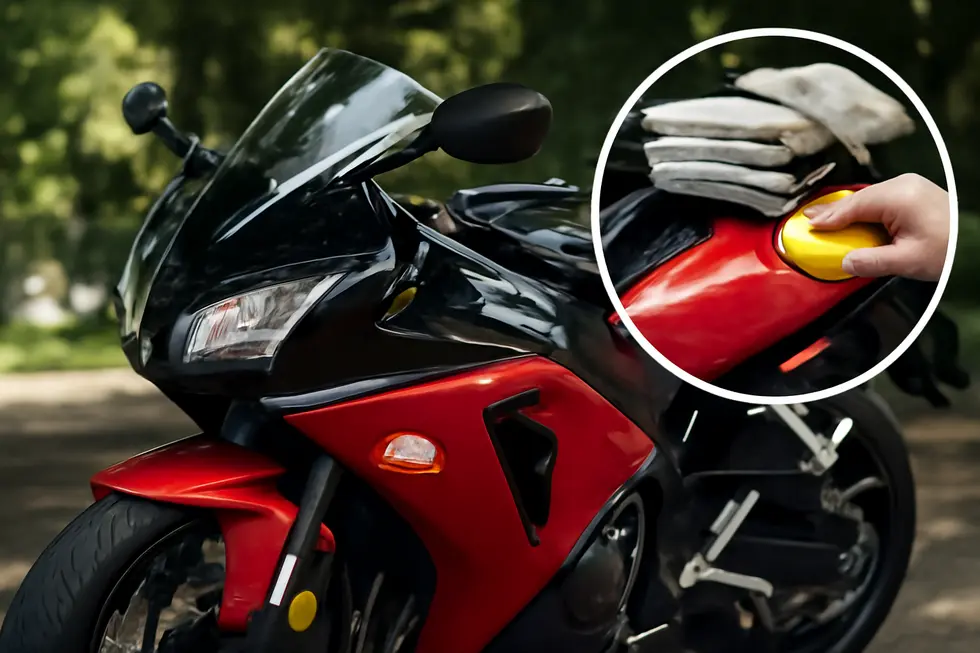
1. Essential Care Techniques to Preserve Motorcycle Fairing Paint’s Vibrancy and Durability
Achieving a stunning motorcycle fairing paint job is only part of the journey; preserving its brilliance and durability over time requires dedicated care. Central to this is adopting cleaning practices that protect the paint’s integrity rather than degrade it. Using motorcycle-specific cleaning products avoids harsh chemicals that can strip protective coatings or damage the finish. Soft microfiber cloths gently lift dirt and grime without scratching, while thorough drying prevents unsightly water spots and potential surface damage.
Equally important is the protection against environmental factors, notably UV exposure, which can cause paint colors to fade and clear coats to dull. Applying a UV-protective wax or sealant after cleaning forms a resilient barrier that blocks harmful rays and prevents oxidation. For riders seeking advanced protection, ceramic coatings provide a molecular shield that enhances hardness and repels contaminants, extending the life of the paint job significantly.
Practical measures like parking in shaded spots or using breathable motorcycle covers also reduce the paint’s exposure to sunlight and airborne pollutants. Regular inspections help identify early signs of wear, allowing timely reapplication of protective layers to maintain a fresh, glossy appearance.
These maintenance strategies not only safeguard the aesthetic appeal but also preserve the overall value of a motorcycle. For comprehensive guidance on effective cleaning and protection tailored to motorcycle fairings, exploring detailed resources such as the extensive Summit Fairings maintenance guides can provide valuable insights and tips.
2. Protecting and Restoring Motorcycle Fairings: Tackling Oxidation, Imperfections, and Effective Repairs
Maintaining a motorcycle fairing’s paint job requires consistent care to combat oxidation, surface imperfections, and potential damage. Oxidation gradually dulls paint and breaks down protective layers, often caused by exposure to UV rays and environmental pollutants. Regular washing with mild soap and soft cloths removes dirt without harming the surface, while applying protective waxes or ceramic coatings creates a strong barrier against fading and corrosion. Performing this routine at least monthly preserves the finish even when the bike is parked.
Surface imperfections such as minor scratches and dullness can be addressed through careful wet sanding using ultra-fine grit sandpapers (1500–2000 grit), smoothing out the affected areas evenly. Follow this with a plastic-specific polish or rubbing compound to restore gloss without risking damage from excessive heat or friction. For deeper scratches, precisely applied touch-up paint and a clear coat layer help blend repairs seamlessly into the original finish. Avoid aggressive polishing or machine buffing that can warp or melt ABS plastic fairings.
If damage extends beyond superficial defects, sanding and repainting become necessary to restore flawless appearance. Sometimes, professional refinishing or replacing parts is the best solution. Regularly inspecting fairing fasteners and gently tightening screws after rides can prevent mechanical stress that might cause cracks or paint chips.
Additional longevity tips include storing the motorcycle in a garage or under breathable covers and avoiding harsh chemicals or abrasive cleaning tools. Using motorcycle-specific cleaning products tailored for painted plastics enhances protection and prolongs vibrancy. Following these guidelines ensures a durable, vibrant finish that withstands wear and environmental challenges. For practical insights on meticulous sanding and polishing methods, consider exploring detailed visual guides and tutorials available through expert sources such as the Summit Fairings blog.
3. Essential Protective Strategies to Shield Motorcycle Fairings From UV Damage and Environmental Wear
Maintaining the vibrancy and durability of a motorcycle fairing’s paint requires consistent protective measures against environmental stressors. UV exposure is one of the primary culprits behind fading and oxidation, gradually breaking down paint layers and diminishing gloss. Shielding fairings with UV-blocking covers when parked outdoors or storing the bike in shaded or indoor locations can significantly reduce this damage. Additionally, routine washing using mild, motorcycle-safe cleaners removes dirt, grime, and road salts that otherwise accelerate wear and corrosion.
Applying protective waxes or advanced sealants forms a barrier that guards against moisture, UV rays, and airborne contaminants. These coatings not only enhance the paint’s gloss and depth but also ease future cleaning, preserving the finish’s quality over time. High-quality waxes, when buffed correctly, restore the fairing’s clarity by filling minor imperfections, thereby preventing premature paint deterioration.
For riders seeking longer-term protection, ceramic-based coatings provide exceptional resistance against environmental factors, often lasting for several years with proper maintenance. These coatings bond with the paint surface to create a durable shield that withstands abrasion and fading better than conventional waxes. However, their effectiveness depends on thorough surface preparation and careful application.
Economic considerations favor consistent upkeep since preventive care averts costly repainting or fairing replacement. By investing time and effort in gentle cleaning routines and applying protective layers, enthusiasts preserve their motorcycle’s aesthetic appeal and resale value. For further practical advice and expert insights on fairing care, exploring dedicated resources such as reliable motorcycle fairings blogs can offer valuable guidance and tips.
4. Protecting and Preserving Your Motorcycle Fairing Paint: Key Factors that Influence Durability and Appearance
The lasting beauty and durability of a motorcycle fairing paint job depend on several interconnected factors, foremost being the quality of the fairing material and the precision of the paint process. High-grade materials such as ABS plastic, combined with meticulous multi-step painting techniques, establish a resilient foundation that holds color and gloss over time. However, even the best materials require thoughtful protection against environmental and physical challenges to maintain their pristine appearance.
Sunlight exposure remains a significant threat to paint longevity, with UV rays gradually causing fading and dulling. Minimizing prolonged direct sun exposure by parking in shaded locations or indoors can dramatically slow degradation. Using UV-protective covers adds an extra layer of defense, shielding the paint from harmful rays and temperature fluctuations.
Careful cleaning routines are essential to preserve the paint’s luster. Gentle soaps and soft cloths should replace harsh chemicals and abrasive materials, which risk scratching or eroding the finish. Avoid letting water dry naturally on the surface to prevent mineral deposits that weaken the paint. Applying motorcycle-safe wax periodically creates a protective barrier that enhances gloss and color vibrancy while guarding against environmental contaminants.
Physical damage from scratches, chips, or dents compromises the integrity of the paint and underlying fairing. Routine handling with care and avoiding impacts during riding or storage protects the surface from blemishes that can accelerate wear. Together, these proactive measures—starting with durable materials and careful paint application, followed by environmental shielding and diligent maintenance—significantly extend the life and appeal of your motorcycle’s fairing paint.
For more on selecting quality fairings and maintaining their appearance, consult this detailed resource on affordable motorcycle fairings.
Final thoughts
Delivering a successful motorcycle fairing paint job requires focused expertise in preparation, skilled application techniques, and a commitment to long-term maintenance. Business owners who invest in mastering these detailed stages will see improved product quality, reduced rework, and increased client loyalty. From stripping and sanding through high-build priming to vibrant color application and protective clear coating, every step reinforces the finish’s durability and visual impact. Additionally, educating customers on maintenance preserves the investment, ensuring the appearance and functionality of the fairings last. Embracing these processes turns ordinary paint jobs into a lasting testament to craftsmanship and professionalism, ultimately elevating any motorcycle repair or customization business.
Ready to elevate your ride? Summit Fairings delivers premium, custom-fit fairings that blend style and durability. Whether you’re chasing speed or turning heads, we’ve got your bike covered. Don’t wait—transform your machine today. Click, customize, and ride with confidence. Your perfect fairing is just a few clicks away. Act now!
About us
undefined
RELATED POSTS
View all

